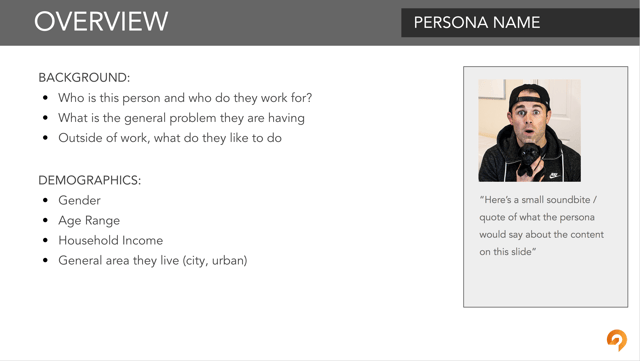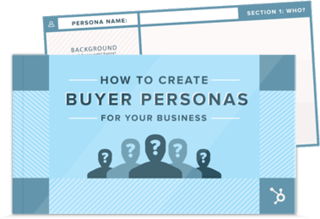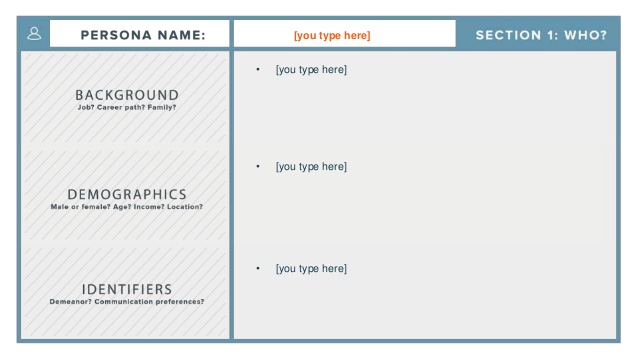What is a buyer persona and why is it important for
Growth-Driven Design?

Buyer personas, also known as “marketing personas,” are your brand’s fictionalized ideal customers. They are characters who represent your business’s ideal customer based on market research and customer profiling.
Buyer personas help shape how your content and website should flow to boost engagement and enable more effective nurturing. Instead of creating the content, or website, that you think will engage your target audience, you are able to shape your content and designs around actual data and preferences of your target audience.
No matter the industry, buyer personas help businesses understand their target audience in a deeper, more meaningful way. Once shaped, they help guide content strategy, buyer journey, website strategy, product development, and any customer facing aspect of a business.
A buyer persona moves your marketing team away from having to guess at what your potential customers want. It guides your strategy and clearly outlines what your ideal customer is searching for, where they are likely to look for information, and what major problems they face that your solution helps solve.
Buyer personas provide a clear understanding of, not only, your ideal buyer but also their
Growth Driven Design, as well as content strategy, is easier when approaching each decision with a buyer persona in mind. You are able to think about the choices you need to make for your website’s design, layout, and workflows, and align them with the buyer journey based a persona’s needs and habits.
Buyer Personas Improve Effectiveness and Results. If you don’t know who you are speaking to, designing, or solving a problem for, both your messaging and design will fall flat. How can you have a strong strategy in place to attract leads and convert them, if you do not have a clear profile of who you aim to attract?
With buyer personas as your foundation, your content, design, and nurturing is stronger and more effective. Your buyer journey is more accurate, and you have a better chance at serving up the right content, offers, and emails (at the right time) to better nurture your leads and create more opportunities.
Buyer personas help your entire organization understand the exact profile of your target customer. They help everyone understand how to communicate in a more effective and meaningful way - whether they are in sales or designing the new home page.
Buyer personas help marketing create better content - geared specifically to the right audience. Everything from blog articles, email marketing
With
Finally, design teams can create websites that flow in a way that is intuitive for your target customer – based on the way they want to interact with content and graphics - and provide an enticing site that leads them further along their journey with your brand.

To craft the perfect buyer persona for your business, you need to understand the questions, attributes, and pain-points of your target customer.
Tip: If you’re just getting started, HubSpot offers an easy to use Buyer Persona Template.
While you may have a general idea of who your company is aiming to sell to, honing in on what actually makes them tick as a person - their wants, needs, feels, questions, quirks, job, family - allows your company to better align your product, service, and content to a “real person,” instead of a broad, hypothetical group.
For example - you may sell software to marketers. Without a buyer persona, this group is large, undefined, and has many different types of buyers within it. By narrowing down and honing in on your core target audience through personas, you are able to understand that, yes, you are targeting a marketer, but your marketer’s name is Mary, she works specifically in email marketing, is usually about 30 – 45, and reports to the CEO of a startup. Suddenly, you have an actual picture of who you are trying to reach.
While you will have some idea of who your persona is, based on target industry and role, you will most likely need to do a bit of market research to dive into who your actual customers and opportunities are. Some businesses have one or two personas, others have ten plus. Start with your most important personas and work your way up. It’s not about having a large number of personas - it’s about understanding your core target personas in a deeper, more meaningful way.

While data from your CRM and sales team’s feedback are all relevant to creating buyer personas, the number one way to understand your target customer is to, well, talk to one.
Before you can conduct your buyer persona interview, you must first find a person who fits your ideal customer profile.
As mentioned above, if you have existing customers you will want to start with them. After all, they have already bought from you - finding out why, and how your solution helps solve their individual problems will allow you to quickly craft a buyer persona.
Contact both customers you currently work with, and customers who are no longer using your product. This is important, as you are trying to really understand who is the best fit for your product. A previous customer can tell you a lot about who may not be an ideal persona for your company to engage with.
For example, maybe you tend to sell your solution to companies with marketing teams. When you dive into lost customers vs. current customers you might notice that the majority of people who have stopped working with you have teams of less than five people. This type of insight can help you understand that a company with few marketing team members is probably not your target.
Talk to your sales team about their current opportunities and their most recent lost opportunities.
Ask:
These insights help you narrow down even further the person, team structure, organization, needs, and problems faced by your ideal buyer.

Up until this point, we have only discussed crafting personas based on data that a company might have if it has already had success in sales, or at least been able to talk to potential customers.
If you are just starting out, creating a buyer persona is the foundation for how you will attract the right type of visitors to your website. You need to have personas, but where do you start when you don’t have customers?
Start with who you think your ideal customer is. Start broadly. For instance, if you know that your target customer is probably a marketer who is running an ecommerce shop’s email marketing campaigns, find an ecommerce focused forum, Quora answer thread, or LinkedIn group, and dig into discussions there. Message one-on-one to ask what your ideal persona’s needs are, and who knows, you might even get some new opportunities while you’re at it.
When conducting your interviews, you will want to make sure you hit upon questions surrounding the interviewee’s:
Below are some questions to help guide your interview relating to the above categories.
Goals
Challenges
Company
Role
Decision Making Style
Personal Life
Would you like 4 great Buyer Persona Templates to streamline getting started?
Get Buyer Persona Templates
As your company and product evolve, your buyer personas will inevitably evolve as well. Make sure you adjust as necessary, conducting surveys with both customers and lost customers every few quarters to ensure your personas are still on point with your idea customers.
With your buyer personas setting a foundation for your customer facing communications and website, you will improve engagement, increase leads, and push your company toward greater opportunities as your messaging, site flow, and buyer journey are perfectly matched to the goals and actions of your ideal buyer.

